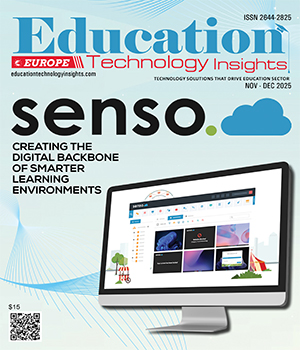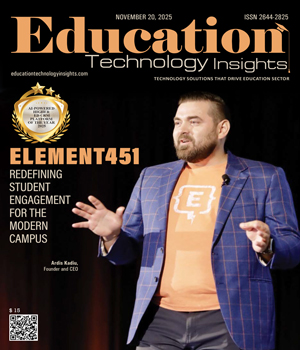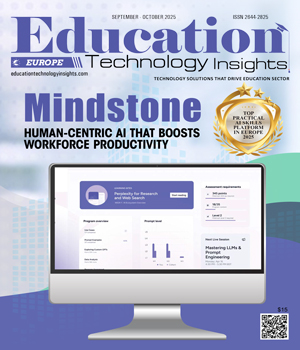THANK YOU FOR SUBSCRIBING
Be first to read the latest tech news, Industry Leader's Insights, and CIO interviews of medium and large enterprises exclusively from Education Technology Insights
Redefining Student Success in the Digital Age
Doug McGee, Director of Teaching, Learning and Assessment, Idaho State University
 Doug McGee, Director of Teaching, Learning and Assessment, Idaho State University
Doug McGee, Director of Teaching, Learning and Assessment, Idaho State UniversityDoug McGee, began his career as a political science professor in the late 1990s before gaining experience in the private sector and returning to higher education in 2013. Over the years, he has witnessed the evolution of conversations around student persistence, retention and completion, shifting from placing responsibility solely on students to examining the role of institutional barriers. Guided by the belief that higher education should go beyond preparing students for careers to fostering lifelong learning and community contribution, McGee is committed to advancing strategies that keep student learning at the center of academic transformation.
The Evolving Landscape of Technology-Enabled Teaching and Student-Centered Assessment
The landscape of higher education is constantly evolving and institutions must adapt to meet the changing needs of both society and students. Research shows that Gen Z—and soon Gen Alpha—prioritize digital engagement. They expect a high-tech learning environment with interactive experiences and on-demand virtual resources that are both accessible and meaningful.
For faculty, this requires integrating emerging technologies, particularly artificial intelligence, in ways that promote active learning, equity and accessibility. At the same time, assessment must move beyond rote recall to emphasize authentic demonstrations of learning that reflect the skills students need beyond the classroom.
When evaluating new technologies, we resist adopting them simply because they are novel or popular. Instead, we ask how they advance our mission: Does this tool make learning more accessible? Does it help faculty design equitable assessments? For example, when piloting AI-enabled tutoring platforms, we looked past flashy features to determine whether they truly helped close achievement gaps for students who might not otherwise have access to support.
In this way, technology serves our institutional goals by strengthening both student learning and faculty engagement, rather than becoming an end in itself.
Key Challenges in Leadership and How They Are Addressed
One of the most persistent challenges in higher education is making assessment truly meaningful and our university is no exception. Too often, assessment is treated as a compliance exercise for accreditation rather than a tool for improving learning. We are working intentionally to reframe it as a space for experimentation and innovation. Rather than focusing on reports and checkboxes, we ask faculty to test new approaches, reflect on what worked and adapt based on their insights.
“By positioning assessment as an opportunity to try new ideas, including integrating emerging technologies such as artificial intelligence, we are shifting the culture from compliance to curiosity.”
Through department-level conversations and the support of our new Center for Learning and Instructional Excellence, faculty are encouraged to treat assessment as a laboratory—designing activities and measures that not only align with program learning outcomes but also foster creativity in teaching practice. By positioning assessment as an opportunity to try new ideas, including integrating emerging technologies such as artificial intelligence, we are shifting the culture from compliance to curiosity. Our goal is not just to document what students have accomplished, but to discover new ways of engaging them more deeply in their learning.
Shaping the Next Era of Teaching and Learning in Higher Education
The next era of teaching and learning in higher education will be shaped most significantly by artificial intelligence, transforming how courses are designed, how students are engaged and how personalized support is delivered. When applied thoughtfully, AI can reduce barriers to access, provide on-demand feedback and help close equity gaps, provided faculty receive the support needed to integrate it effectively into their teaching.
This evolution aligns with the broader shift toward active, authentic and student-centered learning. Today’s students expect more than lectures and exams; they seek interactive experiences, real-world applications and opportunities to demonstrate their skills in meaningful ways. To make this transformation possible, centers for teaching and learning and instructional designers will be essential in guiding faculty to experiment with new methods, learn from outcomes and scale what proves effective.
Empowering the Next Generation of Education Innovators
Moving forward, it is not enough to determine whether students are meeting broad objectives; we must look deeper to understand which students are thriving, which are struggling and why. Closing equity gaps requires both self-reflection and the courage to reimagine teaching in ways that make learning accessible to all.
Faculty also need support and training to see the potential of digital assessment tools such as e-portfolios, not merely as grading mechanisms but as vehicles for timely, actionable feedback. When used effectively, these tools foster interactive, authentic learning experiences. Instructional designers and early-career educators play a vital role in helping faculty adopt and adapt these approaches, creating lasting impact.
Read Also
Navigating Course Map Design
Beyond the Classroom: Supporting Belonging and Wellbeing for International Students
Building Responsible AI Practice Across a University
Designing Engagement That Lasts
Digital Creativity as a Catalyst for Deeper Learning
Protecting Precious Cargo: A Comprehensive Look at School Bus Safety

I agree We use cookies on this website to enhance your user experience. By clicking any link on this page you are giving your consent for us to set cookies. More info

However, if you would like to share the information in this article, you may use the link below:
www.educationtechnologyinsightseurope.com/cxoinsights/doug-mcgee-nid-3428.html






















